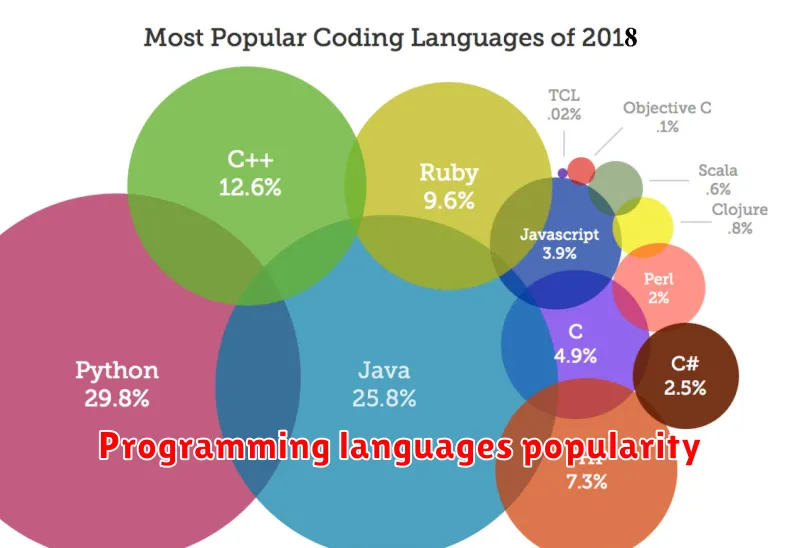In the ever-evolving tech landscape, staying ahead of the curve is paramount. The demand for skilled programmers continues to surge, making it crucial to equip yourself with the right skills. Knowing the top programming languages to master can significantly boost your career prospects and unlock a world of opportunities in 2024. This article will explore the hottest programming languages that are driving innovation and shaping the future of technology.
From web development and mobile apps to data science and artificial intelligence, these languages are in high demand across diverse industries. Whether you’re a seasoned developer or just starting your coding journey, understanding the latest trends and mastering the most sought-after languages is essential for success. So, let’s dive into the exciting world of programming and discover the languages that will empower you to build amazing things in 2024.
The Ever-Evolving Landscape of Programming Languages
The world of programming is constantly in flux, with new languages emerging and existing ones evolving at a rapid pace. This dynamic landscape is driven by advancements in technology, shifting industry demands, and the pursuit of more efficient and versatile solutions. Understanding this ever-changing environment is crucial for programmers seeking success in the tech industry.
The rise of cloud computing, artificial intelligence, and big data has propelled the demand for languages like Python, Java, and JavaScript. These languages offer powerful frameworks and libraries that cater to the complexities of modern applications. Furthermore, the emergence of low-code and no-code platforms has democratized programming, making it accessible to a wider audience. However, even with these advancements, established languages like C++ and C# continue to hold their ground in areas requiring performance optimization and resource management.
Navigating this evolving landscape requires adaptability and a willingness to learn. Programmers must continuously update their skills, explore new languages, and stay abreast of the latest trends. Ultimately, success lies in mastering the languages that align with emerging technologies and the specific needs of the industry.
Factors to Consider When Choosing a Programming Language
In the ever-evolving landscape of technology, mastering the right programming language can be a game-changer for your career success. With numerous languages vying for your attention, making the right choice can seem daunting. Here are some key factors to consider when selecting a programming language:
1. Your Career Goals and Interests
Before diving into any language, it’s crucial to align your choice with your career aspirations and areas of interest. Do you see yourself building web applications, developing mobile apps, or delving into data science? Identifying your goals will help you narrow down the options and select a language that aligns with your future path.
2. Demand and Industry Trends
Researching the current demand and future trends in the industry is vital. Look at job postings, industry reports, and popular programming communities to gain insights into which languages are in high demand and likely to remain relevant in the coming years.
3. Learning Curve and Resources
The learning curve associated with a particular language should be a significant factor in your decision. Some languages are known for their simplicity, while others demand a steeper learning curve. Consider your existing programming knowledge and the availability of learning resources, such as online courses, tutorials, and communities.
4. Community Support and Ecosystem
A vibrant and supportive community can be a valuable asset in your learning journey. Look for languages with robust communities, ample documentation, and active forums. A strong ecosystem also implies a wider selection of libraries, frameworks, and tools to enhance your development process.
5. Specific Project Requirements
If you’re working on a specific project, the project’s requirements should guide your language choice. Consider the type of application you’re building, the platform you’re targeting (web, mobile, desktop), and the technologies used within the project.
By carefully considering these factors, you can make an informed decision that sets you on the path to achieving your career goals in the dynamic world of programming.
Python: The Undisputed King of Versatility

In the ever-evolving landscape of programming, Python has emerged as a dominant force, consistently ranking among the most popular and sought-after languages. Its versatility, readability, and extensive libraries make it an ideal choice for a wide range of applications. From web development and data science to machine learning and automation, Python’s capabilities are truly remarkable.
One of the key factors contributing to Python’s popularity is its simplicity. Its syntax is clean and concise, making it relatively easy to learn and understand, even for beginners. This ease of learning allows developers to quickly grasp the fundamentals and start building functional applications.
Another major advantage of Python is its vast ecosystem of libraries and frameworks. These pre-built modules offer a wide range of functionalities, saving developers significant time and effort. Whether it’s NumPy for numerical computing, Pandas for data analysis, or Django for web development, Python has a library for virtually every need.
Beyond its technical merits, Python enjoys a thriving and supportive community. This vibrant community actively contributes to the language’s development, provides assistance to learners, and fosters a collaborative environment. This strong community support ensures that Python remains relevant and constantly evolves to meet the demands of the ever-changing technology landscape.
In conclusion, Python’s versatility, readability, extensive libraries, and supportive community make it an undeniable force in the programming world. Whether you’re a seasoned developer or just starting out, mastering Python is a valuable investment for your future success in 2024 and beyond.
JavaScript: Powering the Interactive Web
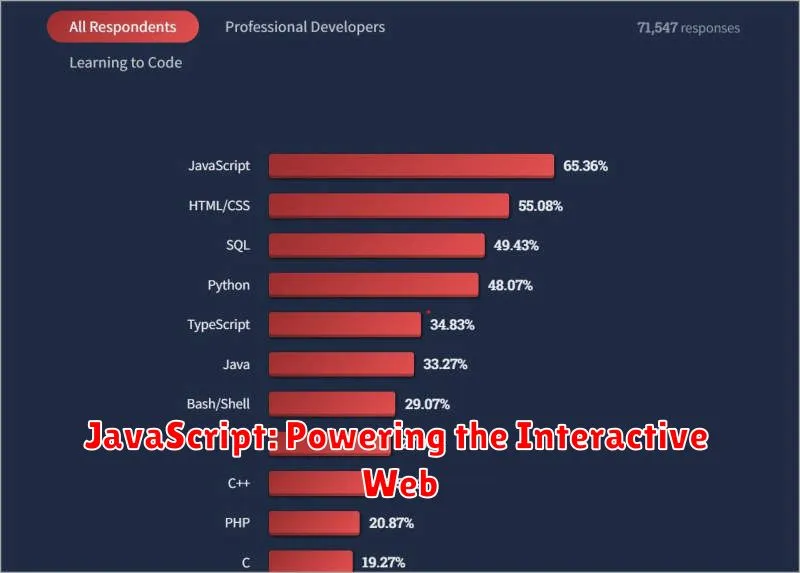
In the ever-evolving landscape of web development, JavaScript stands as a cornerstone, driving the interactivity and dynamic experiences that users have come to expect. Its versatility and wide adoption have made it a must-have skill for any aspiring web developer.
At its core, JavaScript empowers developers to manipulate web page elements, handle user interactions, and create engaging animations. From simple form validation to complex web applications, JavaScript provides the tools to bring web pages to life.
Beyond its traditional use in web browsers, JavaScript has extended its reach to server-side development through frameworks like Node.js, enabling developers to build scalable and efficient backend systems.
In the realm of modern web development, JavaScript continues to evolve with the emergence of frameworks like React, Angular, and Vue.js, simplifying the process of building complex user interfaces and facilitating the creation of dynamic, responsive web applications.
Java: The Enterprise-Grade Workhorse

In the ever-evolving landscape of programming languages, Java remains a stalwart, consistently ranking among the top choices for developers. Its reputation as a robust, reliable, and versatile language has solidified its position as an enterprise-grade workhorse.
Java’s widespread adoption stems from its numerous advantages:
- Platform independence: Java’s “write once, run anywhere” philosophy allows code to execute seamlessly across various operating systems, eliminating compatibility issues.
- Object-oriented programming: Java’s object-oriented paradigm fosters code reusability, modularity, and maintainability, making it ideal for large-scale projects.
- Rich ecosystem: A vast collection of libraries, frameworks, and tools provides developers with a comprehensive toolkit for building sophisticated applications.
- Strong community support: Java boasts a vibrant and active community, offering ample resources, documentation, and assistance to developers.
- Security: Java emphasizes security features, making it a preferred choice for developing applications that handle sensitive data.
These strengths make Java particularly well-suited for developing enterprise applications, including:
- Web applications
- Mobile applications
- Cloud-based services
- Big data processing
- Financial systems
In 2024 and beyond, Java will continue to be a dominant force in the enterprise space, thanks to its enduring stability and adaptability. Whether you’re a seasoned developer or a newcomer to the world of programming, mastering Java can open doors to a wide range of exciting career opportunities.
C++: The Foundation of Systems Programming

In the realm of programming, certain languages stand out as pillars of strength and versatility. Among them, C++ reigns supreme as a powerful and efficient language, renowned for its ability to build robust and high-performance systems. Its dominance stems from its profound impact on diverse domains, including operating systems, game engines, embedded systems, and high-performance computing.
C++’s legacy as a foundation for systems programming is deeply rooted in its design philosophy, prioritizing performance and control. Its low-level access to hardware, coupled with its ability to manage memory directly, empowers developers to create resource-efficient applications. This level of control is essential for crafting applications that require maximum speed and minimal overhead, such as real-time systems, device drivers, and resource-constrained environments.
Furthermore, C++’s extensive standard library provides a rich set of tools and functionalities for tasks such as data structures, algorithms, and input/output operations. This rich library simplifies development, enabling developers to focus on the core logic of their applications rather than reinventing the wheel.
The enduring influence of C++ is evident in its widespread adoption across industries. It serves as the bedrock for many popular operating systems, game engines, and database systems. Its flexibility and performance make it a go-to choice for building complex, high-demand applications that push the boundaries of technology.
C#: The Go-To Language for Microsoft Technologies

In the dynamic world of technology, staying ahead of the curve is essential for career success. As we embark on 2024, mastering the right programming languages can significantly impact your career trajectory. Among the contenders, C# stands out as a crucial language for those seeking opportunities within the Microsoft ecosystem.
C# is a versatile, object-oriented programming language developed by Microsoft. Its popularity stems from its tight integration with .NET Framework and .NET Core, powerful platforms that underpin a wide array of Microsoft technologies. From web applications and mobile apps to desktop software and game development, C# empowers developers to build robust and scalable solutions across diverse domains.
Here’s why C# reigns supreme in the Microsoft realm:
- Seamless Integration: C# is inherently designed to work seamlessly with Microsoft technologies, offering a smooth and efficient development experience.
- Extensive Libraries: .NET Framework and .NET Core provide a vast collection of libraries and tools, making it easier for developers to build complex applications with minimal effort.
- Strong Community Support: C# enjoys a vibrant and active community, offering abundant resources, support forums, and learning materials.
- High Demand: The demand for C# developers remains strong, with numerous job opportunities available across various industries.
If your career aspirations lie in the Microsoft ecosystem, mastering C# is a strategic move. Its versatility, robust capabilities, and strong community support make it an invaluable asset for any developer looking to excel in the tech world.
Swift: Apple’s Modern and Intuitive Language
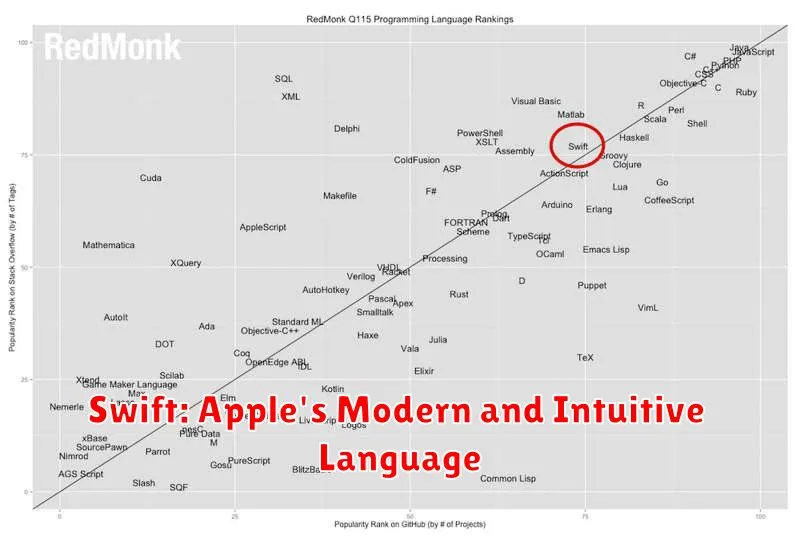
Swift, developed by Apple in 2014, is a modern, safe, and fast programming language designed to build apps for Apple’s diverse range of platforms, including iOS, iPadOS, macOS, watchOS, and tvOS. Its intuitive syntax and focus on safety make it an excellent choice for both beginners and experienced programmers.
Swift’s key features include:
- Safety: Swift emphasizes type safety, preventing common programming errors and promoting clean code.
- Performance: Swift is designed to be fast and efficient, making it ideal for building high-performance apps.
- Modern Syntax: Swift’s concise and expressive syntax makes it easy to write and read code.
- Open Source: Swift is open-source, allowing developers to contribute to its development and leverage a vast community for support.
- Interoperability: Swift can interact with existing Objective-C code, making it easy to integrate into existing iOS projects.
For those looking to develop iOS apps, mastering Swift is crucial. It’s a language that empowers developers to build innovative and engaging experiences for Apple’s vast user base.
Go: Google’s Language for Concurrency and Scalability

In the ever-evolving landscape of software development, mastering the right programming languages is crucial for success. Among the many contenders, Go, also known as Golang, stands out as a powerful choice for building robust, scalable, and concurrent applications. Developed by Google, Go is specifically designed to address the challenges of modern software development, particularly in areas where concurrency and performance are paramount.
One of Go’s defining features is its exceptional support for concurrency. Unlike traditional threading models, Go uses goroutines, lightweight threads managed by the runtime, enabling developers to write highly concurrent applications without the complexities of managing threads manually. This makes Go an ideal choice for building applications that need to handle numerous requests and tasks simultaneously, such as web servers, distributed systems, and data processing pipelines.
Go’s focus on simplicity and readability contributes to its growing popularity. Its syntax is clean and concise, making it easier to learn and write code that is maintainable and understandable. Go also emphasizes efficiency, with its garbage collection and static typing ensuring that programs run smoothly and predictably.
Furthermore, Go’s strong community and extensive library support make it a developer-friendly language. Its growing ecosystem provides developers with a vast array of tools, frameworks, and packages to expedite their development process.
If you are looking to master a programming language that prioritizes concurrency, scalability, and developer productivity, Go should be at the top of your list. Its strengths make it an ideal choice for building modern applications that meet the demands of today’s complex and interconnected world.
Kotlin: The Modern Alternative for Android Development
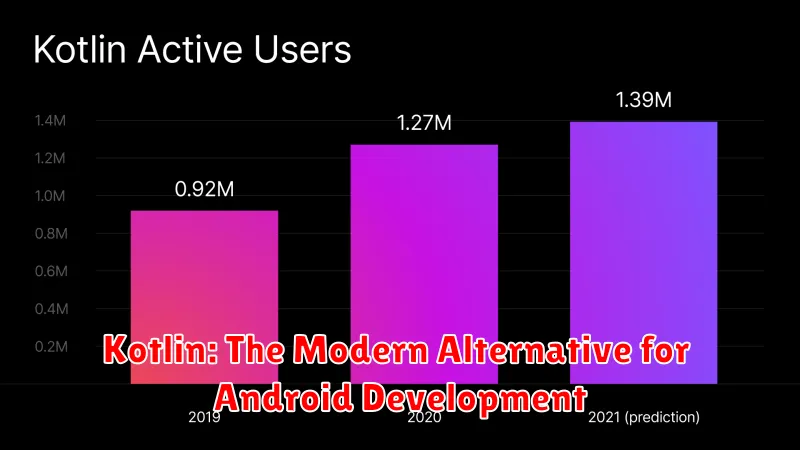
In the rapidly evolving landscape of mobile app development, choosing the right programming language is crucial for success. While Java has long been the go-to language for Android, a new contender has emerged, gaining immense popularity and recognition: Kotlin.
Developed by JetBrains, Kotlin is a modern, concise, and expressive programming language that offers numerous advantages for Android development. Its key features, such as null safety, concise syntax, and interoperability with Java, make it an attractive choice for developers seeking to build robust and efficient apps.
Kotlin’s null safety is a game-changer, eliminating the dreaded NullPointerExceptions that plague Java code. By requiring explicit handling of nullable values, Kotlin helps developers write more reliable and predictable code. Its concise syntax, with fewer boilerplate codes, improves readability and reduces development time. Furthermore, Kotlin’s seamless interoperability with Java allows developers to gradually migrate their existing Java codebases to Kotlin, making the transition smooth and effortless.
Google’s official endorsement of Kotlin as a first-class language for Android development has solidified its position as a modern alternative. With its powerful features, strong community support, and growing ecosystem of libraries and tools, Kotlin empowers developers to build high-quality Android apps with ease and efficiency.
Emerging Programming Languages to Watch Out For
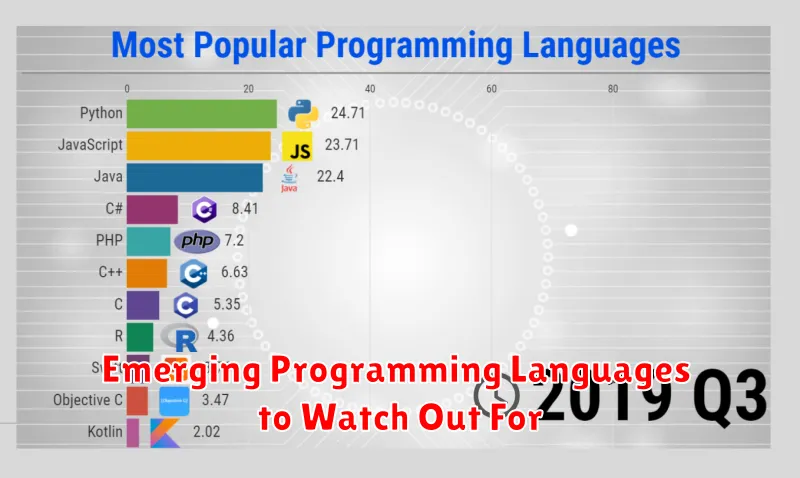
The programming landscape is constantly evolving, with new languages emerging and gaining popularity. While established languages like Java and Python remain dominant, it’s essential to keep an eye on the emerging programming languages that could shape the future of software development. These languages often bring new features, paradigms, and solutions to address the evolving demands of the tech industry. Here are some exciting emerging programming languages to watch out for in 2024:
1. Rust: Known for its focus on memory safety and performance, Rust has been gaining significant traction. Its robust type system helps prevent memory leaks and data races, making it an excellent choice for building reliable and high-performance applications. Rust’s popularity is rising due to its use in various domains, including systems programming, web development, and blockchain technology.
2. Kotlin: Developed by JetBrains, Kotlin has become the preferred language for Android development. Its concise syntax and interoperability with Java have made it a compelling choice for building modern Android apps. Kotlin’s popularity is also extending beyond Android, with its use in web development, server-side applications, and data science.
3. Swift: Created by Apple, Swift is a modern and safe language designed for iOS, macOS, watchOS, and tvOS development. Its intuitive syntax, focus on safety, and excellent performance have made it a popular choice for building native applications on Apple platforms. Swift’s ecosystem is expanding rapidly, with frameworks and libraries supporting a wide range of applications.
4. Go: Developed at Google, Go is a statically-typed, compiled language that emphasizes simplicity and efficiency. Its concurrency features make it well-suited for building scalable and distributed systems. Go’s popularity is growing in areas such as cloud computing, DevOps, and microservices.
5. TypeScript: A superset of JavaScript, TypeScript introduces static typing to enhance code maintainability and scalability. Its type system helps catch errors early and improves code readability. TypeScript has become increasingly popular for large-scale JavaScript projects, particularly in web development and frontend frameworks.
As the tech landscape continues to evolve, keeping up with emerging programming languages is crucial for software developers. These languages offer new opportunities and challenges, empowering developers to build innovative solutions and stay ahead of the curve.

